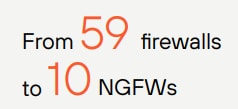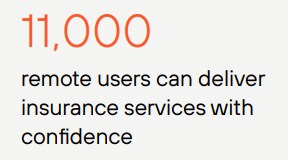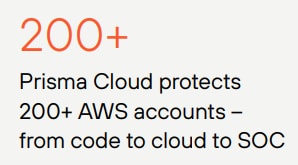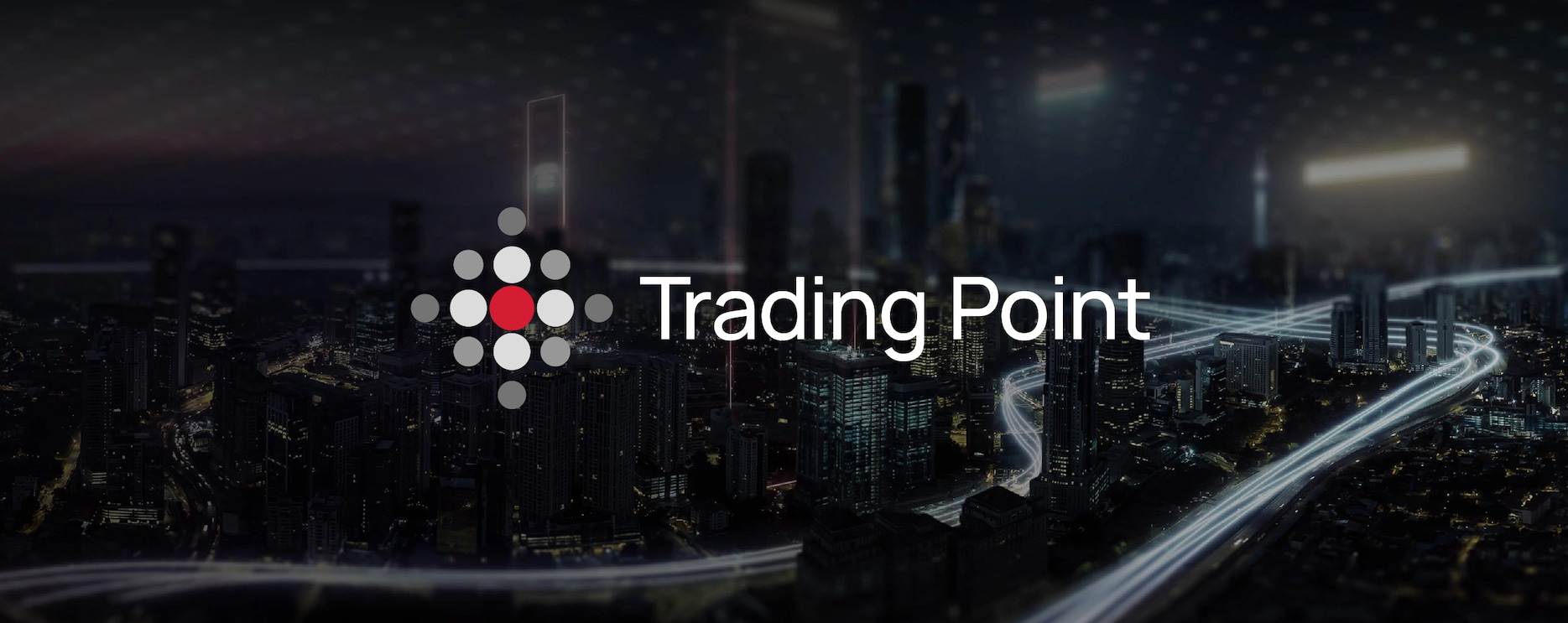Five-day outage damages brand reputation
‘Complex’ was the word most commonly associated with this insurance giant’s cybersecurity. Multiple overlapping network security platforms not only undermined security visibility and response time – but they also impacted availability. On one occasion, the client services network was down for five days, leaving the company unable to sell or market policies – triggering incalculable damage to brand reputation and revenue.
Other cybersecurity challenges included:
- Remote connectivity: The legacy virtual private network (VPN) struggled to scale from 1,000 to 11,000 users. It was expensive and lacked advanced security protection, reporting, and other capabilities.
- Efficiency: Precious security time was diverted to managing threat root cause analysis, VPN connectivity, and other issues across 59 different firewalls.
- Cloud security: Development and security teams managed code and pipeline security on 200+ AWS accounts manually, potentially delaying the launch of new insurance services.
- Support: Existing security vendors varied significantly in terms of expertise, quality of support, and speed of response.
“Palo Alto Networks is consistently ahead of everyone else, being among the first security partners to grasp the concept of network security and cloud security. We can now focus on ‘business as usual’ programmes, not on putting out fires.”
Cybersecurity Architect,
Forbes Global 2000 organisation
Security journey
Security that is “best-in-class across the board”
In response, the organisation chose to secure its reputation, customer trust, and bottom line with a Palo Alto Networks platformization approach.
“Palo Alto Networks cloud and network security are best-in-class across the board. And it all works together to deliver robust, automated security that frees resources to focus on strategic initiatives,” says the organisation’s Security Operations Manager.
-
Achieves ‘magic six’ availability
![]() Simplified network security replaces 59 different firewalls with approximately 10 Palo Alto Networks Next-Generation Firewalls (NGFWs). Features such as AI-powered deep learning and zero-delay signatures contribute to secure 99.9999% availability, raising the bar in protection. “Since the deployment, we haven’t experienced a single ‘Priority One’ incident,” the Security Operations Manager comments.
Simplified network security replaces 59 different firewalls with approximately 10 Palo Alto Networks Next-Generation Firewalls (NGFWs). Features such as AI-powered deep learning and zero-delay signatures contribute to secure 99.9999% availability, raising the bar in protection. “Since the deployment, we haven’t experienced a single ‘Priority One’ incident,” the Security Operations Manager comments.Security is amplified and simplified through seamless integration between the firewalls and the company’s AWS environment, which the Security Operations Manager says is “Among the top 10 largest AWS-Managed Services deployments worldwide.”
He also trusts the technology implicitly: “We’ve just re-signed with Palo Alto Networks for another four years. That demonstrates our confidence in their technology and people.”
-
Agile and secure remote access
![Agile and secure remote access]() By swapping out the legacy VPN platform and proxy browsing tools for Prisma Access, the insurer scaled seamlessly from 1,000 to 11,000 remote users, with 8,000 more in the pipeline. People now have the flexibility to connect to data from anywhere both quickly and easily.
By swapping out the legacy VPN platform and proxy browsing tools for Prisma Access, the insurer scaled seamlessly from 1,000 to 11,000 remote users, with 8,000 more in the pipeline. People now have the flexibility to connect to data from anywhere both quickly and easily.This AI-powered secure access service edge (SASE) platform dramatically reduces the risk of a data breach. Where previously up to 100,000 threats were detected, billions are now visible, almost all being resolved automatically without human intervention.
“The intuitive reporting means that we can share dashboards on the applications, threats, and security subscriptions across the network,” says the Cybersecurity Architect.
-
Increases operational efficiency
The platform has saved the eight security professionals three hours each per day in administration time – equivalent to 24 hours per day in total. It has also reduced the unpopular night-time administration.
“We use Strata Cloud Manager and AIOps a lot. They allow us to easily manage both the firewalls and SASE environment from the cloud, saving hours,” says the Cybersecurity Architect. “Having a complete network security management and operations solution powered by AI allows us to simplify the management of multiple solutions, providing real-time visibility into all users, applications, and devices, as well as continuous security inspection.”
-
Security from code to cloud to SOC
![Security from code to cloud to SOC]() Prisma Cloud is used to protect the company’s multicloud environment, including Azure and 200+ AWS accounts. It combines cloud posture security and vulnerability management in a unified data lake, cutting through the noise and accelerating issue resolution.
Prisma Cloud is used to protect the company’s multicloud environment, including Azure and 200+ AWS accounts. It combines cloud posture security and vulnerability management in a unified data lake, cutting through the noise and accelerating issue resolution.“With a single platform from code to cloud to SOC, we have complete visibility from the source code and pipelines to deployment workloads. That way, we can act and innovate faster,” says the organisation’s Cloud Security Manager.
Application security also provides end-to-end security across the entire software development lifecycle. By correlating code, pipeline, runtime, and application context, teams can accurately assess risk, prioritise vulnerabilities, and prevent threats from reaching production.
“We compared Prisma Cloud against other similar technologies, and it was significantly superior in detecting vulnerabilities in code,” explains the Cloud Security Manager.




 Simplified network security replaces 59 different firewalls with approximately 10 Palo Alto Networks Next-Generation Firewalls (NGFWs). Features such as AI-powered deep learning and zero-delay signatures contribute to secure 99.9999% availability, raising the bar in protection. “Since the deployment, we haven’t experienced a single ‘Priority One’ incident,” the Security Operations Manager comments.
Simplified network security replaces 59 different firewalls with approximately 10 Palo Alto Networks Next-Generation Firewalls (NGFWs). Features such as AI-powered deep learning and zero-delay signatures contribute to secure 99.9999% availability, raising the bar in protection. “Since the deployment, we haven’t experienced a single ‘Priority One’ incident,” the Security Operations Manager comments. By swapping out the legacy VPN platform and proxy browsing tools for Prisma Access, the insurer scaled seamlessly from 1,000 to 11,000 remote users, with 8,000 more in the pipeline. People now have the flexibility to connect to data from anywhere both quickly and easily.
By swapping out the legacy VPN platform and proxy browsing tools for Prisma Access, the insurer scaled seamlessly from 1,000 to 11,000 remote users, with 8,000 more in the pipeline. People now have the flexibility to connect to data from anywhere both quickly and easily. Prisma Cloud is used to protect the company’s multicloud environment, including Azure and 200+ AWS accounts. It combines cloud posture security and vulnerability management in a unified data lake, cutting through the noise and accelerating issue resolution.
Prisma Cloud is used to protect the company’s multicloud environment, including Azure and 200+ AWS accounts. It combines cloud posture security and vulnerability management in a unified data lake, cutting through the noise and accelerating issue resolution.






